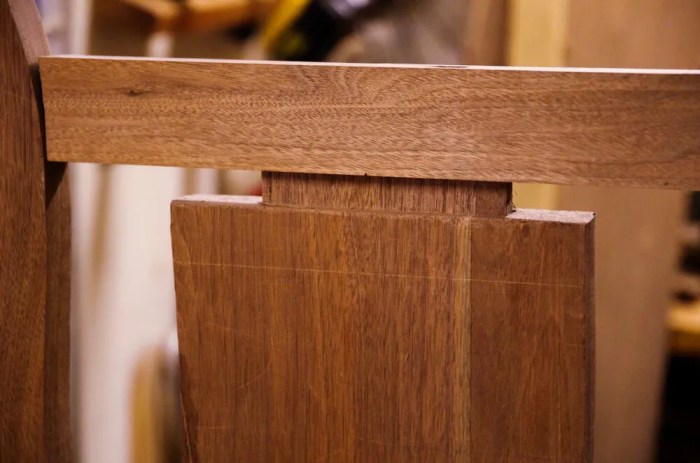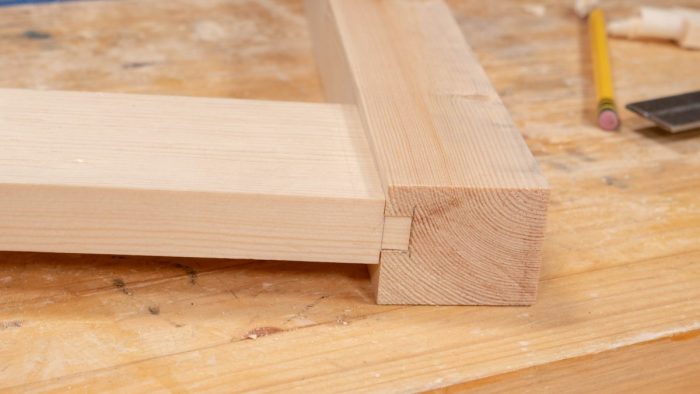Mortise and tenon joint advantages – In the realm of woodworking, the mortise and tenon joint stands as a testament to the enduring power of traditional craftsmanship. Its advantages, spanning strength, versatility, aesthetics, ease of assembly, and historical significance, make it an indispensable technique for woodworkers of all levels.
From the sturdy construction of ancient structures to the intricate details of fine furniture, the mortise and tenon joint has left an enduring mark on the art of woodworking.
Strength and Durability

Mortise and tenon joints exhibit exceptional structural integrity, making them ideal for applications where strength is paramount. The interlocking design creates a rigid connection that resists separation under stress. This joint is commonly employed in load-bearing structures such as bridges, buildings, and heavy-duty furniture.
The mortise and tenon joint ensures longevity due to its resistance to loosening and wear. The tight fit and interlocking design prevent movement and maintain the joint’s integrity over time.
Versatility and Flexibility
Mortise and tenon joints are highly adaptable and can be utilized in a wide range of woodworking projects. They are commonly found in furniture, cabinetry, and construction applications. The joint allows for adjustments and modifications, making it suitable for various designs and purposes.
For example, in furniture making, mortise and tenon joints are used to connect chair legs to seats, tabletops to bases, and drawer fronts to frames. In cabinetry, they are employed to assemble cabinets, drawers, and shelves. In construction, they are used to create sturdy frames for buildings and other structures.
Aesthetic Appeal

Mortise and tenon joints possess a timeless beauty that complements both traditional and contemporary designs. The exposed joinery adds character and craftsmanship to furniture, cabinetry, and architectural elements.
In decorative applications, mortise and tenon joints are often used to create intricate patterns and designs. For example, they can be found in carved furniture, decorative panels, and architectural moldings.
Ease of Assembly
Mortise and tenon joints are relatively straightforward to assemble, making them suitable for both experienced woodworkers and beginners. The process typically involves cutting a mortise (a square or rectangular hole) into one piece of wood and a tenon (a protruding tongue) into the other.
The tenon is then inserted into the mortise, and the joint is secured with glue or pegs.
Various tools can be used to create mortise and tenon joints, including chisels, saws, and power tools. The specific tools and techniques will depend on the size and complexity of the joint.
Historical Significance

Mortise and tenon joints have a rich history dating back to ancient times. They have been used in construction and furniture making for centuries, and their design has evolved over time to meet the needs of different cultures and applications.
Evidence of mortise and tenon joints has been found in ancient Egyptian artifacts and Chinese furniture. The technique was also widely used in European and American furniture making, particularly during the Colonial and Victorian eras.
FAQ Resource: Mortise And Tenon Joint Advantages
What is a mortise and tenon joint?
A mortise and tenon joint is a type of woodworking joint that involves creating a rectangular hole (mortise) in one piece of wood and a protruding tongue (tenon) on another piece of wood, which are then fitted together to form a strong and durable connection.
What are the advantages of using mortise and tenon joints?
Mortise and tenon joints offer numerous advantages, including exceptional strength, versatility, aesthetic appeal, ease of assembly, and historical significance.
How do you make a mortise and tenon joint?
Creating a mortise and tenon joint requires careful preparation and precision. It typically involves using chisels and saws to create the mortise and tenon, which are then fitted together and secured with glue or pins.